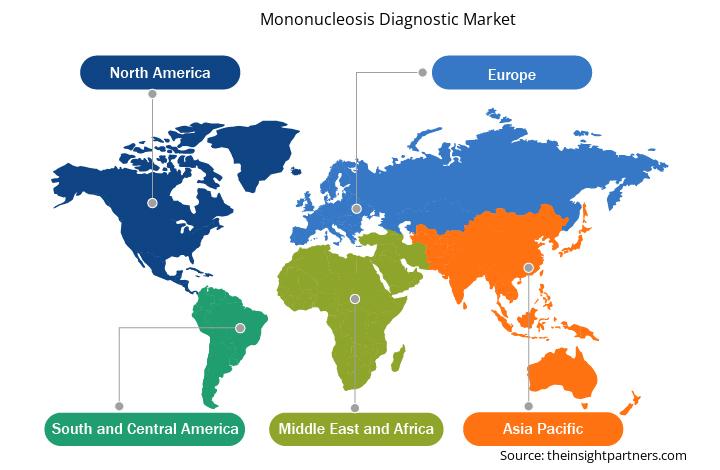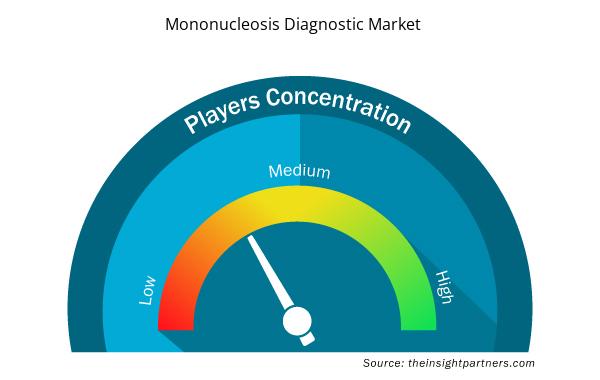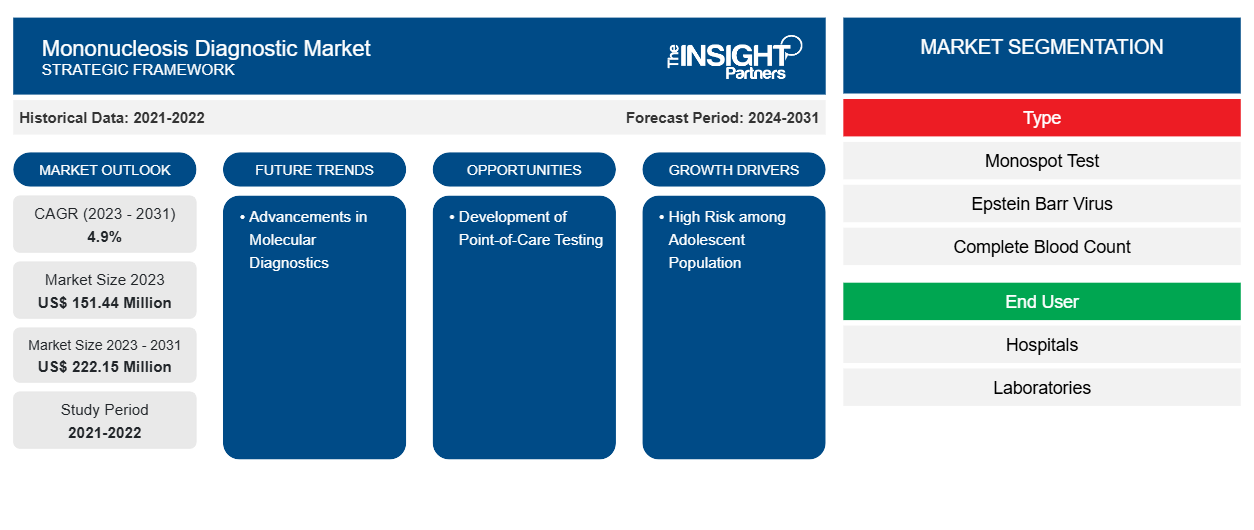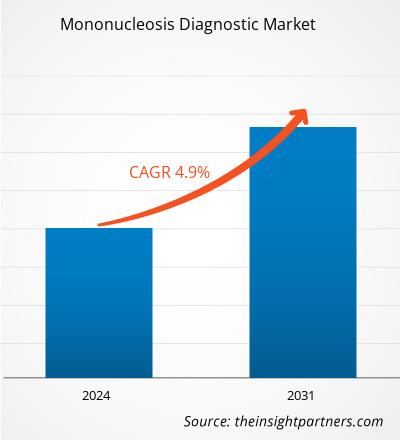Si prevede che la dimensione del mercato della diagnostica della mononucleosi raggiungerà i 222,15 milioni di dollari entro il 2031, rispetto ai 151,44 milioni di dollari del 2023. Si prevede che il mercato registrerà un CAGR del 4,9% nel periodo 2023-2031. È probabile che i progressi nella diagnostica molecolare introducano nuove tendenze di mercato durante il periodo di previsione.
Analisi di mercato della diagnosi della mononucleosi
Come definito dalle Nazioni Unite, la popolazione adolescente (10-19 anni) attraversa un periodo di transizione dall'infanzia all'età adulta con una crescita e uno sviluppo significativi. Secondo il Fondo delle Nazioni Unite per l'infanzia (UNICEF), ci sono 1,3 miliardi di adolescenti nel mondo, che costituiscono il 16% della popolazione totale del mondo. La mononucleosi, spesso definita "la malattia del bacio", colpisce principalmente adolescenti e giovani adulti. L'incidenza di questa malattia è in aumento con la crescente popolazione adolescente. Il virus di Epstein-Barr (EBV) è la causa più comune di questa malattia, che spesso si diffonde attraverso la saliva durante i baci o la condivisione di bevande.
Gli operatori sanitari sperimentano una forte domanda di test diagnostici efficaci per identificare e confermare la mononucleosi negli adolescenti. I test monospot, i test degli anticorpi EBV e le colture faringee sono i metodi diagnostici consolidati per questa malattia. Il test monospot prevede il rilevamento di anticorpi specifici nel sangue, mentre il test degli anticorpi EBV si concentra specificamente sul rilevamento degli anticorpi anti-EBV. Molti operatori sanitari si stanno anche concentrando sull'offerta di test point-of-care e servizi di telemedicina, che si rivolgono specificamente ai pazienti più giovani che preferiscono la comodità di una diagnosi rapida e domiciliare. Queste innovazioni facilitano le diagnosi tempestive, riducendo le barriere all'accesso e aumentando il tasso complessivo di test. La capacità di identificare rapidamente i casi di mononucleosi porta a una migliore gestione dei pazienti e riduce al minimo l'impatto della malattia sulla vita accademica e sociale. Pertanto, l'elevato rischio di mononucleosi tra gli adolescenti si traduce in una significativa domanda di prodotti e servizi diagnostici.
Panoramica del mercato della diagnosi della mononucleosi
Il mercato della diagnosi della mononucleosi si sta espandendo rapidamente a causa dell'elevato rischio tra la popolazione adolescente e della crescente consapevolezza sanitaria e conoscenza della malattia. I principali attori che operano nel mercato si stanno concentrando sull'innovazione e sulla collaborazione per una maggiore disponibilità del prodotto. Inoltre, si prevede che i progressi nella diagnosi molecolare introdurranno nuove tendenze di mercato nei prossimi anni. Tuttavia, la bassa accuratezza dei test diagnostici esistenti ostacola la crescita del mercato della diagnosi della mononucleosi.
Personalizza questo report in base alle tue esigenze
Riceverai la personalizzazione gratuita di qualsiasi report, comprese parti di questo report, o analisi a livello nazionale, pacchetto dati Excel, oltre a usufruire di grandi offerte e sconti per start-up e università
- Scopri le principali tendenze di mercato in questo rapporto.Questo campione GRATUITO includerà analisi di dati che spaziano dalle tendenze di mercato alle stime e alle previsioni.
Driver e opportunità del mercato diagnostico della mononucleosi
La crescente consapevolezza sanitaria e la conoscenza della mononucleosi alimentano la crescita del mercato
La crescente consapevolezza sanitaria e la conoscenza della mononucleosi sono i fattori chiave che guidano il mercato della diagnostica della mononucleosi. Man mano che gli individui diventano più informati sui problemi di salute, in particolare sulle malattie infettive uniche come la mononucleosi, tendono a essere più proattivi nel cercare diagnosi e trattamento. Con una migliore alfabetizzazione sanitaria, gli individui sono meglio attrezzati per riconoscere i sintomi della mononucleosi, tra cui stanchezza estrema , febbre, mal di gola e linfonodi ingrossati. Anche la diagnosi precoce è fondamentale per una gestione efficace, poiché aiuta a prevenire le complicazioni e riduce la durata della malattia. L'accesso alle informazioni tramite Internet, i social media e le campagne educative consente ai pazienti di identificare questi sintomi con maggiore certezza. Di conseguenza, la maggiore consapevolezza si traduce in un aumento della domanda di test diagnostici.
L'ascesa dei social media e delle risorse sanitarie online ha cambiato radicalmente il modo in cui le persone accedono alle informazioni sui problemi di salute. Piattaforme come Instagram, Twitter e Facebook fungono da canali per condividere esperienze personali e approfondimenti di esperti in merito alla mononucleosi. Influencer, professionisti sanitari e organizzazioni utilizzano queste piattaforme per diffondere informazioni accurate, demistificare la condizione e combattere la disinformazione. Di conseguenza, le persone stanno diventando più istruite sulla mononucleosi, il che porta a un maggiore coinvolgimento dei pazienti nel processo decisionale riguardante la gestione, la diagnosi e il trattamento della malattia. Il cambiamento di mentalità avvantaggia i pazienti e migliora il sistema sanitario complessivo promuovendo una gestione sanitaria proattiva.
La crescente consapevolezza sanitaria si allinea anche con la tendenza più ampia di cure preventive abbracciata dai sistemi sanitari in tutto il mondo. L'enfasi sulla prevenzione spinge la domanda di test diagnostici per la mononucleosi. Gli operatori sanitari stanno rispondendo incorporando screening di routine e materiali educativi nelle loro pratiche, normalizzando ulteriormente il processo di ricerca di una diagnosi.
Sviluppo di test Point-of-Care per creare opportunità redditizie nel mercato
I test POC consentono una diagnosi rapida presso o vicino al sito di cura del paziente, consentendo agli operatori sanitari di prendere decisioni cliniche immediate e migliorare i risultati per i pazienti. I test di laboratorio tradizionali spesso richiedono ore o giorni per generare risultati, il che può ritardare il trattamento e peggiorare i sintomi. Al contrario, i test POC possono fornire risultati in pochi minuti, facilitando un intervento tempestivo. La rapida inversione di tendenza è particolarmente cruciale per condizioni come la mononucleosi, poiché una diagnosi precoce può ridurre le complicazioni e migliorare il comfort del paziente. I test POC possono essere implementati in vari contesti sanitari, tra cui ambulatori, pronto soccorso e strutture di assistenza domiciliare. L'accessibilità è particolarmente vantaggiosa nelle aree con infrastrutture di laboratorio limitate o nelle regioni rurali con risorse sanitarie insufficienti. Avvicinare le capacità diagnostiche ai pazienti sotto forma di test POC garantisce che più individui ricevano diagnosi tempestive e cure appropriate, ampliando così la portata dei servizi sanitari. Inoltre, questo tipo di test promuove un maggiore coinvolgimento, poiché i pazienti possono ricevere rapidamente i loro risultati e discutere i passaggi successivi con i loro operatori sanitari.
I test POC possono essere più convenienti rispetto ai test di laboratorio tradizionali, in quanto non necessitano di infrastrutture di laboratorio estese, riducendo a loro volta i costi complessivi per i sistemi sanitari. L'accessibilità economica dei test per la mononucleosi ne aumenta ulteriormente l'accessibilità a una gamma più ampia di pazienti, in particolare nelle popolazioni meno assistite. I recenti progressi nei biosensori e nelle tecnologie microfluidiche stanno guidando lo sviluppo di test POC più sofisticati con sensibilità e specificità migliorate. Queste innovazioni garantiscono l'affidabilità dei test POC nel rilevamento della mononucleosi. Gli operatori di mercato che offrono kit per test POC includono SEKISUI Diagnostics (OSOM Mono Test), Abbott (Clearview Mono) e Cardinal Health [Cardinal Health MONO (Mononucleosis) II Rapid Test]. Pertanto, lo sviluppo dei test POC genera sostanziali opportunità di crescita per gli operatori di mercato della diagnostica per la mononucleosi.
Analisi della segmentazione del rapporto di mercato sulla diagnosi della mononucleosi
I segmenti chiave che hanno contribuito alla derivazione dell'analisi di mercato della diagnosi della mononucleosi sono la tipologia e l'utente finale.
- In base al tipo, il mercato della diagnostica della mononucleosi è segmentato in test degli anticorpi del virus di Epstein Barr, test dell'emocromo completo e test monospot. Il segmento del test monospot ha detenuto la quota maggiore del mercato nel 2023.
- In termini di utente finale, il mercato della diagnostica della mononucleosi è suddiviso in ospedali, laboratori e altri. Il segmento ospedaliero ha dominato il mercato nel 2023.
Analisi della quota di mercato della diagnosi della mononucleosi per area geografica
L'ambito geografico del rapporto di mercato sulla diagnosi della mononucleosi si concentra principalmente su cinque regioni: Nord America, Asia Pacifico, Europa, Sud e Centro America e Medio Oriente e Africa. In termini di fatturato, il Nord America ha dominato il mercato nel 2023. Si stima che dominerà il mercato globale durante il periodo di previsione. Gli Stati Uniti sono il più grande mercato al mondo per la diagnosi della mononucleosi e si stima che domineranno il mercato anche durante il periodo di previsione. La crescita del mercato negli Stati Uniti è attribuita ai progressi tecnologici, alla maggiore consapevolezza e alla costante necessità di strategie efficaci di gestione delle malattie. Secondo i National Institutes of Health, gli Stati Uniti registrano circa 125.000 casi di mononucleosi infettiva ogni anno. A causa di un numero così elevato, anche la consapevolezza della mononucleosi causata dal virus di Epstein-Barr (EBV) è in aumento nel paese, il che rafforza la domanda di kit di test diagnostici rapidi e accurati, materiali di consumo e servizi. I vari metodi di test adottati dagli operatori sanitari nel paese includono test sierologici basati sul rilevamento di anticorpi e test molecolari focalizzati sull'identificazione del DNA virale. Il panorama competitivo del mercato della diagnostica della mononucleosi negli Stati Uniti è dominato da aziende come Abbott Laboratories, Roche Diagnostics e Siemens Healthineers. Queste aziende investono in innovazione e collaborazioni per migliorare la loro offerta di prodotti ed espandere la loro presenza sul mercato.
Approfondimenti regionali sul mercato della diagnosi della mononucleosi
Le tendenze regionali e i fattori che influenzano il mercato della diagnostica della mononucleosi durante il periodo di previsione sono stati ampiamente spiegati dagli analisti di Insight Partners. Questa sezione discute anche i segmenti e la geografia del mercato della diagnostica della mononucleosi in Nord America, Europa, Asia Pacifico, Medio Oriente e Africa e America meridionale e centrale.

- Ottieni i dati specifici regionali per il mercato della diagnosi della mononucleosi
Ambito del rapporto di mercato sulla diagnosi della mononucleosi
| Attributo del report | Dettagli |
|---|---|
| Dimensioni del mercato nel 2023 | 151,44 milioni di dollari USA |
| Dimensioni del mercato entro il 2031 | 222,15 milioni di dollari USA |
| CAGR globale (2023-2031) | 4,9% |
| Dati storici | 2021-2022 |
| Periodo di previsione | 2024-2031 |
| Segmenti coperti | Per tipo
|
| Regioni e Paesi coperti | America del Nord
|
| Leader di mercato e profili aziendali chiave |
|
Densità degli attori del mercato diagnostico della mononucleosi: comprendere il suo impatto sulle dinamiche aziendali
Il mercato del mercato diagnostico della mononucleosi sta crescendo rapidamente, spinto dalla crescente domanda degli utenti finali dovuta a fattori quali l'evoluzione delle preferenze dei consumatori, i progressi tecnologici e una maggiore consapevolezza dei benefici del prodotto. Con l'aumento della domanda, le aziende stanno ampliando le loro offerte, innovando per soddisfare le esigenze dei consumatori e capitalizzando sulle tendenze emergenti, il che alimenta ulteriormente la crescita del mercato.
La densità degli operatori di mercato si riferisce alla distribuzione di aziende o società che operano in un particolare mercato o settore. Indica quanti concorrenti (operatori di mercato) sono presenti in un dato spazio di mercato in relazione alle sue dimensioni o al valore di mercato totale.
Le principali aziende che operano nel mercato della diagnosi della mononucleosi sono:
- Laboratori Abbott
- Arlington Scientific Inc
- Laboratori Bio-Rad Inc.
- Cardinale Salute Inc
- Meridian Bioscience Inc
- Diagnostica Sekisui LLC
Disclaimer : le aziende elencate sopra non sono classificate secondo un ordine particolare.

- Ottieni una panoramica dei principali attori del mercato della diagnosi della mononucleosi
Notizie e sviluppi recenti sul mercato della diagnosi della mononucleosi
Il mercato della diagnostica della mononucleosi viene valutato raccogliendo dati qualitativi e quantitativi dopo la ricerca primaria e secondaria, che includono importanti pubblicazioni aziendali, dati di associazioni e database. Di seguito è riportato uno sviluppo chiave osservato nel mercato della diagnostica della mononucleosi:
- Meridian Bioscience, Inc., un fornitore leader a livello mondiale di soluzioni per test diagnostici e materie prime per le scienze della vita, insieme a SD Biosensor, Inc. e SJL Partners LLC, ha annunciato il completamento dell'acquisizione di Meridian. (Fonte: sito Web di Meridian Bioscience, Inc., gennaio 2024)
Copertura e risultati del rapporto sul mercato della diagnosi della mononucleosi
Il rapporto "Dimensioni e previsioni del mercato della diagnostica della mononucleosi (2021-2031)" fornisce un'analisi dettagliata del mercato che copre le seguenti aree:
- Dimensioni e previsioni del mercato diagnostico della mononucleosi a livello globale, regionale e nazionale per tutti i principali segmenti di mercato coperti dall'ambito
- Tendenze del mercato diagnostico della mononucleosi, nonché dinamiche di mercato quali fattori trainanti, limitazioni e opportunità chiave
- Analisi PEST e SWOT dettagliate
- Analisi di mercato della diagnosi della mononucleosi che copre le principali tendenze del mercato, il quadro globale e regionale, i principali attori, le normative e i recenti sviluppi del mercato
- Analisi del panorama industriale e della concorrenza che copre la concentrazione del mercato, l'analisi della mappa di calore, i principali attori e gli sviluppi recenti per il mercato della diagnosi della mononucleosi
- Profili aziendali dettagliati
- Analisi storica (2 anni), anno base, previsione (7 anni) con CAGR
- Analisi PEST e SWOT
- Valore/volume delle dimensioni del mercato - Globale, regionale, nazionale
- Industria e panorama competitivo
- Set di dati Excel


- Employment Screening Services Market
- Medical Collagen Market
- Procedure Trays Market
- Health Economics and Outcome Research (HEOR) Services Market
- Hydrolyzed Collagen Market
- Occupational Health Market
- Dried Blueberry Market
- Railway Braking System Market
- Biopharmaceutical Contract Manufacturing Market
- Customer Care BPO Market

Report Coverage
Revenue forecast, Company Analysis, Industry landscape, Growth factors, and Trends

Segment Covered
This text is related
to segments covered.

Regional Scope
North America, Europe, Asia Pacific, Middle East & Africa, South & Central America

Country Scope
This text is related
to country scope.
Domande frequenti
The market is expected to register a CAGR of 4.9% during 2023–2031.
The mononucleosis diagnostic market value is expected to reach US$ 222.15 million by 2031.
Advancements in molecular diagnostics are likely to bring new growth trends in the market in the coming years.
Abbott Laboratories, Arlington Scientific Inc, Bio-Rad Laboratories Inc, Cardinal Health Inc, Meridian Bioscience Inc, Sekisui Diagnostics LLC, Thermo Fisher Scientific Inc, QuidelOrtho Corp, F. Hoffmann-La Roche Ltd, QIAGEN NV, Hologic Inc, bioMerieux SA, DiaSorin SpA, Immunostics Inc., Launch Diagnostics Ltd, Biorex Diagnostics, and ZEUS Scientific are among the key players operating in the market.
The high risk among the adolescent population, and the rising health awareness and knowledge about mononucleosis are among the most significant factors fueling the market growth.
North America dominated the market in 2023.
Trends and growth analysis reports related to Life Sciences : READ MORE..
The List of Companies - Mononucleosis Diagnostic Market
- Abbott Laboratories
- Arlington Scientific Inc
- Bio-Rad Laboratories Inc
- Cardinal Health Inc
- Meridian Bioscience Inc
- Sekisui Diagnostics LLC
- Thermo Fisher Scientific Inc
- QuidelOrtho Corp
- F. Hoffmann-La Roche Ltd
- QIAGEN NV
- Hologic Inc
- bioMerieux SA
- DiaSorin SpA
- Immunostics Inc.
- Launch Diagnostics Ltd
- Biorex Diagnostics
- ZEUS Scientific
The Insight Partners performs research in 4 major stages: Data Collection & Secondary Research, Primary Research, Data Analysis and Data Triangulation & Final Review.
- Data Collection and Secondary Research:
As a market research and consulting firm operating from a decade, we have published and advised several client across the globe. First step for any study will start with an assessment of currently available data and insights from existing reports. Further, historical and current market information is collected from Investor Presentations, Annual Reports, SEC Filings, etc., and other information related to company’s performance and market positioning are gathered from Paid Databases (Factiva, Hoovers, and Reuters) and various other publications available in public domain.
Several associations trade associates, technical forums, institutes, societies and organization are accessed to gain technical as well as market related insights through their publications such as research papers, blogs and press releases related to the studies are referred to get cues about the market. Further, white papers, journals, magazines, and other news articles published in last 3 years are scrutinized and analyzed to understand the current market trends.
- Primary Research:
The primarily interview analysis comprise of data obtained from industry participants interview and answers to survey questions gathered by in-house primary team.
For primary research, interviews are conducted with industry experts/CEOs/Marketing Managers/VPs/Subject Matter Experts from both demand and supply side to get a 360-degree view of the market. The primary team conducts several interviews based on the complexity of the markets to understand the various market trends and dynamics which makes research more credible and precise.
A typical research interview fulfils the following functions:
- Provides first-hand information on the market size, market trends, growth trends, competitive landscape, and outlook
- Validates and strengthens in-house secondary research findings
- Develops the analysis team’s expertise and market understanding
Primary research involves email interactions and telephone interviews for each market, category, segment, and sub-segment across geographies. The participants who typically take part in such a process include, but are not limited to:
- Industry participants: VPs, business development managers, market intelligence managers and national sales managers
- Outside experts: Valuation experts, research analysts and key opinion leaders specializing in the electronics and semiconductor industry.
Below is the breakup of our primary respondents by company, designation, and region:

Once we receive the confirmation from primary research sources or primary respondents, we finalize the base year market estimation and forecast the data as per the macroeconomic and microeconomic factors assessed during data collection.
- Data Analysis:
Once data is validated through both secondary as well as primary respondents, we finalize the market estimations by hypothesis formulation and factor analysis at regional and country level.
- Macro-Economic Factor Analysis:
We analyse macroeconomic indicators such the gross domestic product (GDP), increase in the demand for goods and services across industries, technological advancement, regional economic growth, governmental policies, the influence of COVID-19, PEST analysis, and other aspects. This analysis aids in setting benchmarks for various nations/regions and approximating market splits. Additionally, the general trend of the aforementioned components aid in determining the market's development possibilities.
- Country Level Data:
Various factors that are especially aligned to the country are taken into account to determine the market size for a certain area and country, including the presence of vendors, such as headquarters and offices, the country's GDP, demand patterns, and industry growth. To comprehend the market dynamics for the nation, a number of growth variables, inhibitors, application areas, and current market trends are researched. The aforementioned elements aid in determining the country's overall market's growth potential.
- Company Profile:
The “Table of Contents” is formulated by listing and analyzing more than 25 - 30 companies operating in the market ecosystem across geographies. However, we profile only 10 companies as a standard practice in our syndicate reports. These 10 companies comprise leading, emerging, and regional players. Nonetheless, our analysis is not restricted to the 10 listed companies, we also analyze other companies present in the market to develop a holistic view and understand the prevailing trends. The “Company Profiles” section in the report covers key facts, business description, products & services, financial information, SWOT analysis, and key developments. The financial information presented is extracted from the annual reports and official documents of the publicly listed companies. Upon collecting the information for the sections of respective companies, we verify them via various primary sources and then compile the data in respective company profiles. The company level information helps us in deriving the base number as well as in forecasting the market size.
- Developing Base Number:
Aggregation of sales statistics (2020-2022) and macro-economic factor, and other secondary and primary research insights are utilized to arrive at base number and related market shares for 2022. The data gaps are identified in this step and relevant market data is analyzed, collected from paid primary interviews or databases. On finalizing the base year market size, forecasts are developed on the basis of macro-economic, industry and market growth factors and company level analysis.
- Data Triangulation and Final Review:
The market findings and base year market size calculations are validated from supply as well as demand side. Demand side validations are based on macro-economic factor analysis and benchmarks for respective regions and countries. In case of supply side validations, revenues of major companies are estimated (in case not available) based on industry benchmark, approximate number of employees, product portfolio, and primary interviews revenues are gathered. Further revenue from target product/service segment is assessed to avoid overshooting of market statistics. In case of heavy deviations between supply and demand side values, all thes steps are repeated to achieve synchronization.
We follow an iterative model, wherein we share our research findings with Subject Matter Experts (SME’s) and Key Opinion Leaders (KOLs) until consensus view of the market is not formulated – this model negates any drastic deviation in the opinions of experts. Only validated and universally acceptable research findings are quoted in our reports.
We have important check points that we use to validate our research findings – which we call – data triangulation, where we validate the information, we generate from secondary sources with primary interviews and then we re-validate with our internal data bases and Subject matter experts. This comprehensive model enables us to deliver high quality, reliable data in shortest possible time.


 Ottieni un campione gratuito per questo repot
Ottieni un campione gratuito per questo repot